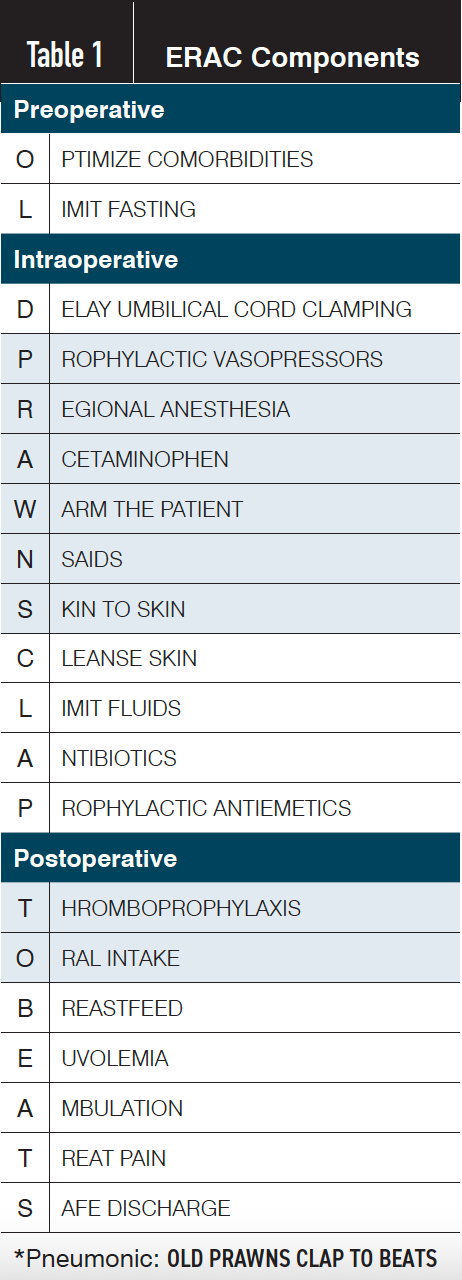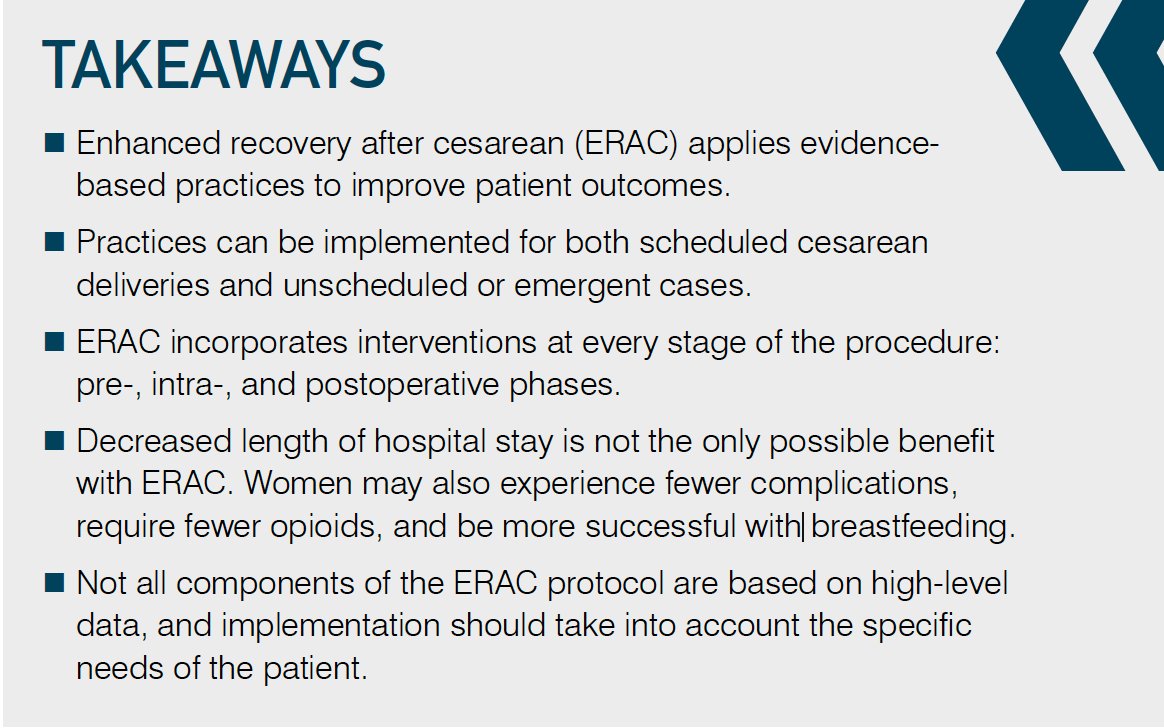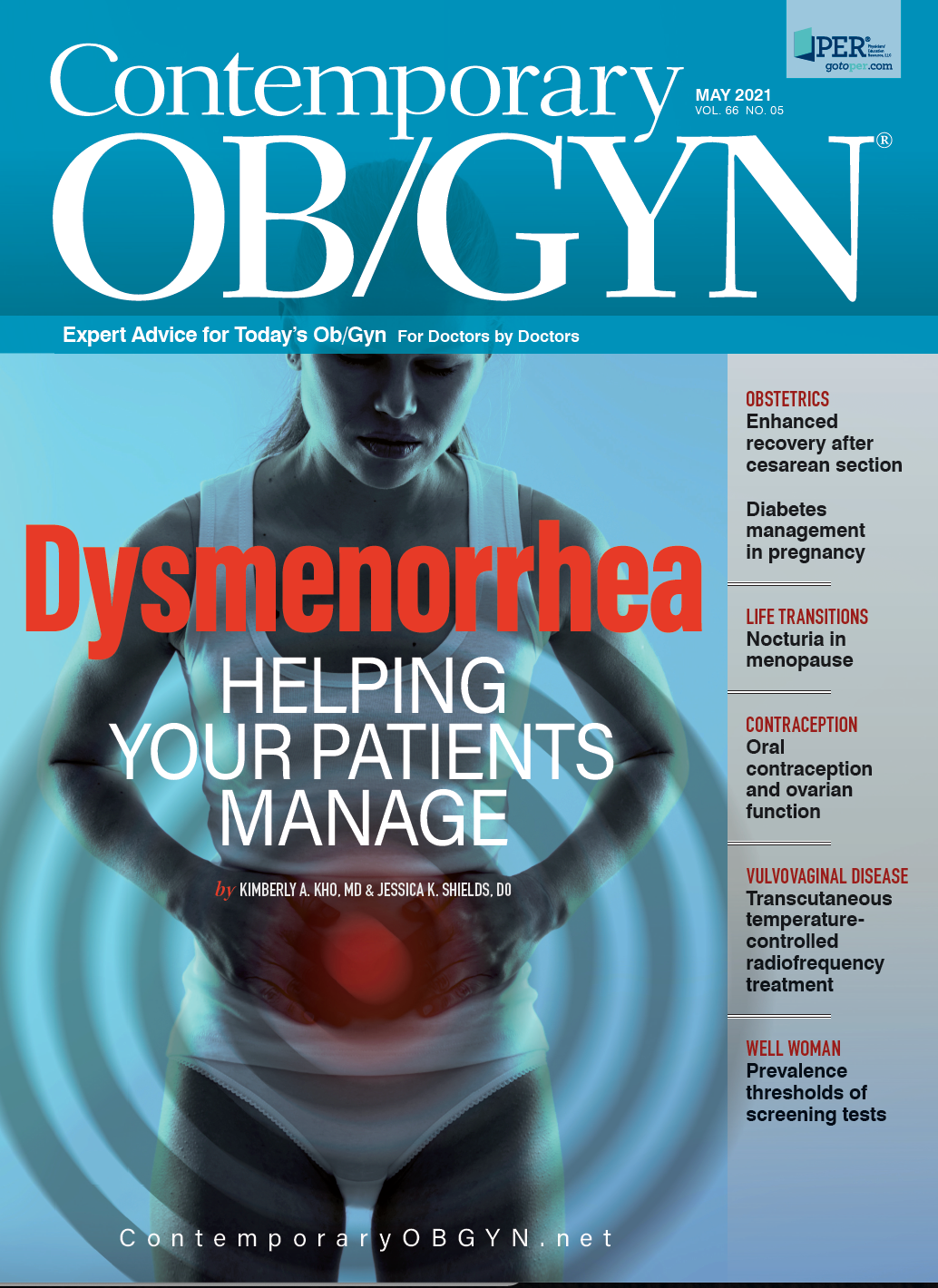Enhanced Recovery After Cesarean Section
Cesarean delivery is the most commonly performed surgery in the United States, with over 1 million infants delivered this way each year. Maternal morbidity and mortality rates in this country are higher in women undergoing cesarean delivery. To improve these outcomes, experts make a case for the application of several ERAS principles to obstetric-specific issues.
View as PDF
Introduction
Enhanced Recovery After Surgery (ERAS) is an evidence-based, multidisciplinary approach to improving surgical care in the perioperative period. ERAS aims to minimize the physiologic response during surgery, optimizing patient outcomes without increasing postoperative complications.1 Enhanced Recovery After Cesarean (ERAC) expands ERAS principles to apply to obstetric-specific issues. This article aims to provide a brief history of ERAS, describe the core components of ERAC, and define the benefits of ERAC on patient outcomes.
History of ERAS
Early ERAS protocols focused on optimizing the experience of outpatient surgical patients. Improving pain control and decreasing postoperative nausea and vomiting were the initial areas of concentration.2 Early ambulation, immediate postoperative pain control, and tempering the nausea that is common after anesthetic medications allowed for a more rapid discharge home and decreased the length of hospital stay.3
ERAS was first developed for colorectal surgery.4 Treating preoperative risk factors helped decrease perioperative pathophysiologic responses and reduced morbidity.5 Preoperative care focused on treating preexisting diseases, improving nutrition, and monitoring for alcohol abuse. Intraoperative efforts were aimed at reducing surgical stress, preventing intraoperative hypothermia, and avoiding unnecessary blood use. The postoperative goals included managing pain, avoiding nausea or vomiting, and early refeeding to avoid ileus. Physicians also placed attention on treating hypoxemia and sleep disturbances.
Other measures included limiting drains and nasogastric tubes and engaging patients in active rehabilitation to lessen muscle mass loss. Standardizing care through these protocols resulted in better patient outcomes. Over time, ERAS protocols were developed for many other surgical subspecialties.
Cesarean delivery remains the most common abdominal surgery in North America, and its rates have remained high despite efforts to prevent primary cesareans.6 ERAC guidelines were introduced in 2018, long after the development of ERAS protocols in many other surgical specialties. New mothers have to balance recovering from major abdominal surgery with caring for an infant.7 Breastfeeding, diaper changes, and the emotional toll of a potentially unplanned surgery take place in the postoperative period. For these reasons, the benefits of ERAC were not immediately apparent.
Core components of ERAC: Evidence-based practices
Preoperative Considerations
The guidelines for ERAC delivery differ slightly based upon scheduled versus unscheduled cesarean deliveries. The pathway begins at 10 to 20 weeks of gestational age for patients who will undergo scheduled cesarean deliveries.6 Comorbidities are optimized for delivery, including screening for and treatment of iron deficiency anemia and optimizing glycemic control for patients with diabetes (Table 1).
Table 1. ERAC Components

The physician discusses ERAC goals with the patient for the preoperative, intraoperative, and postoperative periods.8 Reducing the period of fasting for women undergoing cesarean is emphasized, with a light meal being allowed up to 6 hours before surgery and clear liquids up until 2 hours before administration of anesthesia. For unscheduled or emergent cesarean deliveries, the preoperative pathway is compressed into a 30- to 60–minute window preceding delivery.6
Intraoperative Considerations
The intraoperative pathway minimizes surgical complications and prepares the patient for a safe postoperative course and successful discharge. Intravenous (IV) antibiotics should be administered within 60 minutes of surgical incision.9 First-generation cephalosporins are recommended for all women without allergies, with the addition of azithromycin in women with ruptured membranes. Skin cleansing should occur before incision with adequate drying time. Furthermore, patients should receive at least 2 prophylactic IV antiemetics with different mechanisms of action.8
Regional anesthesia is preferred for cesarean delivery.9 Spinal anesthesia results in shorter block onset than epidurals, and intrathecal morphine helps with postoperative pain control. The guidelines suggest a transversus abdominis plane (TAP) block for patients who do not receive intrathecal or epidural morphine. The administration of ketorolac should occur after peritoneum closure, and scheduled nonopioid analgesia, such as acetaminophen, should be initiated.8 The goal of multimodal anesthesia is to reduce postoperative opioid use.
The use of prophylactic vasopressor infusion is recommended to prevent hypotension secondary to spinal anesthesia and maintain blood pressure at baseline.8 IV fluids should be limited to less than 3 L for routine cases to maintain euvolemia. Published guidelines recommend that oxytocin administration be limited to the amount necessary to achieve and maintain adequate uterine tone.
In an effort to reduce intraoperative hypothermia, guidelines recommend the forced-air warming of the mother, warming IV fluids, and increasing the operating room temperature.9 Hypothermia can have adverse maternal effects, including coagulopathy, cardiac derangements, and higher infection risk. Additionally, neonatal hypothermia can result in adverse outcomes for the infant; therefore, the newborn should be dried and kept warm after delivery.10,11
The ERAC guidelines also address immediate postdelivery infant care. Clamping of the umbilical cord for term infants should be delayed for at least 1 minute, whereas preterm infants should have the clamping delayed for 30 seconds.8 The ability to conduct neonatal resuscitation, if necessary, is vital for all cesarean deliveries. Avoid the routine use of oxygen supplementation and suctioning of the neonatal airway, except in cases of obstruction. Skin-to-skin contact is encouraged immediately after delivery to promote breastfeeding initiation within the first hour of life.
Postoperative Considerations
Success during the postoperative pathway is dependent upon steps taken during the preoperative and intraoperative periods. The primary goal is ensuring patients return to baseline function and progress to successful discharge from the hospital. Early ambulation after resolution of neuraxial anesthetic is thought to decrease the risk of thromboembolic events and is one of the initial steps to return the patient to precesarean functional status.8 Additional, mechanic thromboembolism prophylaxis, such as pneumatic compression devices, is preferred for women not receiving pharmacologic thromboprophylaxis for another indication.12
Maintenance of euvolemia and appropriate intraoperative treatment of hypotension decreases the risk of postoperative nausea and vomiting. Early oral intake of ice chips and water should occur within 60 minutes of admission to the postanesthesia care unit.8 Patients are encouraged to resume a regular diet within 4 hours after surgery if there are no contraindications. Published guidelines recommend the discontinuation of Foley catheters for women who do not require ongoing urine output measurements.10 Early removal of the catheters is thought to facilitate ambulation, and theoretically also reduce the risk of symptomatic urinary tract infections.8
Ideally, the multimodal pain regimen started in the operating room continues, or otherwise is initiated, upon reaching the postanesthesia care unit. A regimen emphasizing the use of acetaminophen and scheduled nonsteroidal anti-inflammatory drugs is favored.12 Prior to discharge, guidelines recommend monitoring the patient for anemia, with hemoglobin lab draws on postoperative day 1 or 2 for women with significant blood volume losses.8 Those found to have anemia should be treated appropriately.
Lastly, mothers should receive breastfeeding support throughout the hospital stay with resources given for outpatient help at the time of discharge.
Interventions and outcomes: Why adopt ERAC principles?
The mission of the ERAS Society is to improve recovery through the use of the best available medical science. In most fields, this equates to shorter recovery times, cost savings, and decreased rates of complications. Usually, this is accomplished by minimizing surgical trauma and postoperative pain, which encourages a rapid return to normal activities.
Length of Stay
In other surgical specialties, instituting ERAS protocols has resulted in drastically decreased postoperative stays.13 The same has proved true for gynecologic surgery.14 However, surgical recovery is often not the rate-limiting factor for women undergoing cesarean delivery. Those who undergo cesarean delivery are also more likely to experience medical complications such as preeclampsia or intrauterine infections, which may dictate hospital length of stay regardless of surgical recovery trajectory.
Additionally, many infants require 2 to 3 days of inpatient care after a cesarean delivery, and earlier discharge of the mother could decouple the mother-infant pair, which is unfavorable for many reasons. Earlier discharge of infants would likely require a greater number of follow-up visits for those infants, with the associated impact on neonatal outcomes unknown, and would likely require greater availability of outpatient lactation services as well.
Thromboembolism Prophylaxis
Unfortunately, solid data on thromboembolism prophylaxis after cesarean delivery are limited given the rarity of the outcome. It is unclear at this time whether encouraging earlier ambulation per the guideline recommendations truly reduces the risk of venous thromboembolism over a short delay in ambulation with the use of pneumatic compression devices. Weighed against the possible increased risk of maternal falls and injuries with ambulation in the setting of waning neuraxial anesthesia, aggressively promoting early ambulation after cesarean may in fact be harmful. If early ambulation is a part of an ERAC protocol, special attention should be paid to nursing protocols to ensure safety at the time of first ambulation.
Early Foley Catheter Removal
Currently, removal of Foley catheters immediately following cesarean delivery is recommended for women who do not require ongoing urine output measurements. This has created some controversy among leading experts. One concern is the lack of existing data on immediate Foley catheter removal in the setting of long-acting neuraxial opioids. This lack of data must be weighed against the unproven benefits of early ambulation.
Additionally, one could assume that immediately removing the Foley catheter may increase the risk of unrecognized hypovolemia. Quantification of blood loss at the time of delivery, despite continued efforts to improve blood loss estimates and the use of quantitative blood loss measurements, is difficult. Often, decreased urine output may be an initial sign of hypovolemia requiring transfusion and is likely more difficult to detect with intermittent voiding.
Reducing Opioid Use
Multimodal pain regimens decrease the amount of opioids required by patients after cesarean delivery. However, the effect is diminished when other measures to control postoperative pain, such as TAP blocks and long-acting intrathecal morphine, are used concurrently.
In fact, investigators of a number of studies examining opioid use with implementation of ERAC protocols have found no reduction in opioid use, though most of the studies included women receiving TAP block and/or intrathecal morphine.15,16 At our institution, where neither TAP block nor intrathecal morphine was routinely used, implementing a multimodal regimen resulted in a dramatic decrease in postoperative opioid use.17
Using nonopioid pain medications prevents the gastrointestinal adverse effects associated with opioids, such as nausea, vomiting, constipation, and decreased bowel motility. Less sedating pain medications also may promote ambulation and activities such as breastfeeding. Additionally, limiting opioid requirements during admission reduces the number of opioids needed for pain control at discharge. Opioid-naive women who receive frequent doses of opioids after cesarean delivery can become dependent after surgery.
Conclusion
Cesarean delivery is the most commonly performed surgery in the United States, with over 1 million infants delivered this way each year. Maternal morbidity and mortality rates in this country are higher than in other developed nations, and rates are higher still in women undergoing cesarean delivery. Therefore, it seems vital that any measure that improves outcomes should be adopted. However, more research is needed to understand which ERAS interventions are most useful in the setting of cesarean delivery.
Some interventions, such as early Foley catheter removal, have proved useful in other surgical specialties but may not prove as useful in obstetrics. Additionally, other facets of ERAC may prove useful not for promoting early discharge, but for improving outcomes such as breastfeeding or reducing post-discharge opioid use. We owe it to pregnant women to find out and implement changes appropriately.

References
1. ACOG Committee Opinion No. 750: Perioperative Pathways: Enhanced Recovery After Surgery. Obstet Gynecol. 2018;132(3):e120-e130. doi:10.1097/AOG.0000000000002818
2. White PF. Management of postoperative pain and emesis. Can J Anaesth. 1995;42(11):1053-1055. doi:10.1007/BF03011082
3. Joshi GP, White PF. Management of acute and postoperative pain. Curr Opin Anaesthesiol. 2001;14(4):417-421. doi:10.1097/00001503-200108000-00007
4. Basse L, Hjort Jakobsen D, Billesbølle P, Werner M, Kehlet H. A clinical pathway to accelerate recovery after colonic resection. Ann Surg. 2000;232(1):51-57. doi:10.1097/00000658-200007000-00008
5. Kehlet H. Multimodal approach to control postoperative pathophysiology and rehabilitation. Br J Anaesth. 1997;78(5):606-617. doi:10.1093/bja/78.5.606
6. Wilson RD, Caughey AB, Wood SL, et al. Guidelines for antenatal and preoperative care in cesarean delivery: Enhanced Recovery After Surgery Society Recommendations (Part 1). Am J Obstet Gynecol. 2018;219(6):523.e1-523.e15. doi:10.1016/j.ajog.2018.09.015
7. Peahl AF, Smith R, Johnson TRB, Morgan DM, Pearlman MD. Better late than never: why obstetricians must implement enhanced recovery after cesarean. Am J Obstet Gynecol. 2019;221(2):117.e1-117.e7. doi:10.1016/j.ajog.2019.04.030
8. Bollag L, Lim G, Sultan P, et al. Society for Obstetric Anesthesia and Perinatology: Consensus Statement and Recommendations for Enhanced Recovery After Cesarean. Anesth Analg. Published online November 3, 2020. doi:10.1213/ANE.0000000000005257
9. Caughey AB, Wood SL, Macones GA, et al. Guidelines for intraoperative care in cesarean delivery: Enhanced Recovery After Surgery Society Recommendations (Part 2). Am J Obstet Gynecol. 2018;219(6):533-544. doi:10.1016/j.ajog.2018.08.006
10. Knobel RB, Wimmer Jr JE, Holbert D. Heat loss prevention for preterm infants in the delivery room. J Perinatol. 2005;25(5):304-308. doi:10.1038/sj.jp.7211289
11. Duryea EL, Nelson DB, Wyckoff MH, et al. The impact of ambient operating room temperature on neonatal and maternal hypothermia and associated morbidities: a randomized controlled trial. Am J Obstet Gynecol. 2016;214(4):505.e1-505.e7. doi:10.1016/j.ajog.2016.01.190
12. Macones GA, Caughey AB, Wood SL, et al. Guidelines for postoperative care in cesarean delivery: Enhanced Recovery After Surgery (ERAS) Society recommendations (part 3). Am J Obstet Gynecol. 2019;221(3):247.e1-247.e9. doi:10.1016/j.ajog.2019.04.012
13. Greco M, Capretti G, Beretta L, Gemma M, Pecorelli N, Braga M. Enhanced recovery program in colorectal surgery: a meta-analysis of randomized controlled trials. World J Surg. 2014;38(6):1531-1541. doi:10.1007/s00268-013-2416-8
14. Scheib SA, Thomassee M, Kenner JL. Enhanced Recovery after Surgery in Gynecology: a review of the literature. J Minim Invasive Gynecol. 2019;26(2):327-343. doi:10.1016/j.jmig.2018.12.010
15. Teigen NC, Sahasrabudhe N, Doulaveris G, et al. Enhanced recovery after surgery at cesarean delivery to reduce postoperative length of stay: a randomized controlled trial. Am J Obstet Gynecol. 2020;222(4):372.e1-372.e10. doi:10.1016/j.ajog.2019.10.009
16. Hedderson M, Lee D, Hunt E, et al. Enhanced recovery after surgery to change process measures and reduce opioid use after cesarean delivery: a quality improvement initiative. Obstet Gynecol. 2019;134(3):511-519. doi:10.1097/AOG.0000000000003406
17. Macias DA, Adhikari EH, Eddins M, Nelson DB, McIntire DD, Duryea EL. A comparison of acute pain management strategies after cesarean delivery. Am J Obstet Gynecol. 2021;224(suppl 2):S524. doi:10.1016/j.ajog.2020.12.866

S4E1: New RNA platform can predict pregnancy complications
February 11th 2022In this episode of Pap Talk, Contemporary OB/GYN® sat down with Maneesh Jain, CEO of Mirvie, and Michal Elovitz, MD, chief medical advisor at Mirvie, a new RNA platform that is able to predict pregnancy complications by revealing the biology of each pregnancy. They discussed recently published data regarding the platform's ability to predict preeclampsia and preterm birth.
Listen
Racial disparities based on delivery hospital quality reported
March 24th 2025A new study found that Black and American Indian birthing individuals in the United States are more likely to deliver at lower-quality hospitals than White patients, highlighting systemic health care inequities.
Read More
sFLT1/PLGF ratio may improve risk stratification for birth outcomes
March 17th 2025A recent study suggests that the soluble fms-like tyrosine kinase 1 to placental growth factor ratio can help predict clinical deterioration, intrapartum fetal distress, and mode of delivery, offering valuable insights for patient counseling and labor management.
Read More
